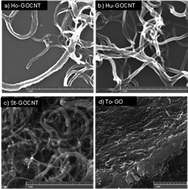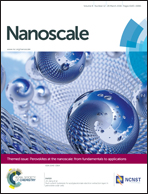Multifunctional electrocatalytic hybrid carbon nanocables with highly active edges on their walls†
Abstract
Graphene sheets exhibit fast heterogeneous electron transfer at the edges while at the basal plane the electron transfer is much slower. Carbon nanotubes (CNTs) represent fascinating quasi-1-dimensional materials due to their electronic and mechanical properties which enable the formation of (unlike graphene) robust, flexible and well defined three dimensional structures. Because CNTs are created from “rolled up” graphene sheets, exposing mostly inactive walls, they generally exhibit poor electrochemical properties. In contrast, graphene sheets can exhibit fast electron transfer rates but are often prone to “restacking” which hinders their true electrochemical potential. Here we obviate this problem by partial unzipping of CNTs, where their inner core creates nanocables with high electrical conductivity while the outer unzipped graphene layers full of edges and defects act as highly electroactive materials. Metallic nanoparticles are introduced into graphene oxide/CNT hybrid structures (GOCNT), so they do catalyze reactions which are not catalyzed by carbon. We show that in combination with trace metal doping, these nanocables act as efficient electrocatalysts towards oxidation of biomarkers and energy related applications, such as hydrogen evolution reaction. Such hybrid graphene/CNT/metallic nanoparticles present universal well-structured catalysts which should find wide applications in electrochemical devices. GOCNTs rich in oxygenated groups show much promise in pollution management, thus their adsorption behaviour was investigated to establish their ability to remove harmful heavy-metal pollutants. The results show an increasing trend in the concentration of oxygen functional groups, directly correlated with the GOCNT adsorption capacity.


 Please wait while we load your content...
Please wait while we load your content...